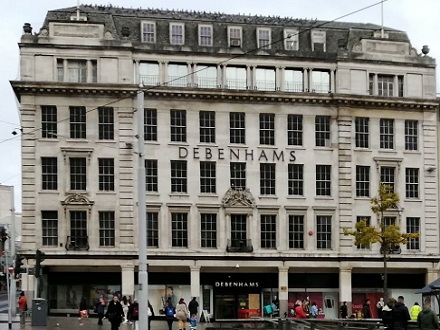What will become of department store buildings?

During the first two weeks of May, the remaining 97 Debenhams stores will close permanently. Their stores in Scotland and on Oxford Street are already closed. House of Fraser and John Lewis are also closing many of their stores. Beales closed their 23 department stores just over one year ago.
It has been suggested that this spells the end of the department store, although Keele Universities Griff Round believes that surviving department stores might benefit through being the “last man standing”.
We have posted about Turning shopping centres into parkland (February 2021) and Converting shops into homes (July 2020) and are supportive of a rethink about the role of town and city centres.
While changes to city centres are needed, department store buildings are among the most problematic. They are simply too big to be taken over by other retailers and they bring shoppers into a particular area which allows nearby shops to thrive.
They are also often much loved buildings in key locations and are landmarks bringing character to the streets they are on.
So what will become of department store buildings?
The 20th Century Society is alarmed that many former department store buildings are likely to be demolished or subjected to unsympathetic alterations. Historic England can give buildings Listed status, but many of the buildings concerned, while much loved, are not designed by famous architects and not old enough to be regarded as historic.
Owners of the buildings can apply for a Certificate of Immunity from Listing, to prevent Historic England from protecting the building, which could allow a building to be demolished. One such application is for the House of Fraser (Rackhams) store in Birmingham. The 20th Century Society has protested against this.
Even when Listed the Society believes that for a determined developer, removing the listing is only a “minor inconvenience”.
Some stores are likely to be demolished. Debenhams in Northampton is likely to be among them, to be replaced by 200 student flats (see our post the student housing boom, April 2021). There is also particular concern about plans to demolish the Debenhams store at Taunton, seen as an important building in the town.
In some cases stores could be demolished to make way for high rise developments.
It would be possible to devise useful and popular alternative uses for the store buildings. But that would be unlikely to satisfy the owners of the buildings. For example the Debenhams store in Nottingham was bought by an investor for £26m just 4 years ago in 2017. Debenhams committed to paying £1.5m a year in rent until 2040. It is difficult to see how an alternative use for the building could raise that sort of money.
The Nottingham building, while not listed, is in a Conservation Area, so the Council can at least give it some level of protection.
Debenhams Manchester was also sold in 2017 – for £87m. It is listed. It is likely to be split into small retail units; but on part of the building a four storey addition will be built, which will be office space.
There are some different possibilities tough: The Exeter store could be turned into a cinema, and the Gloucester store has been bought by the University of Gloucestershire as a teaching centre, with a pledge to maintain the outside of the building as it is, saying that it is “central to the cities heritage”.
Griff Round is arguing for Government intervention to put some buildings to an alternative use saying “we can learn something from the UK’s approach to COVID … a similarly bold approach could address the millions of unwanted square feet. This would not be cheap, but this is a national crisis”.

